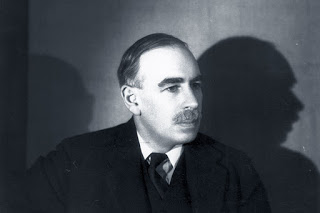Summary:
John Maynard Keynes was a genius on par with Darwin, says, Ann Pettifor, for his revolutionary new way of looking at economics. And some of his theories are still too revolutionary today. Resistance to the book’s content came immediately drafts began to circulate. Keynes, after all, was trying to effect “a revolution . . . in the way the world thinks about economic problems” and it is natural for the mind to mount a defence of its established contents and processes. Keynes’s most important breakthrough was the realization that the “price” of money, or rate of interest, was determined not as the classical theory dictated, by the demand for savings, but by the demand for safe, secure or risky assets. This revolutionary theory – his Liquidity Preference Theory – is still considered too
Topics:
Mike Norman considers the following as important:
This could be interesting, too:
John Maynard Keynes was a genius on par with Darwin, says, Ann Pettifor, for his revolutionary new way of looking at economics. And some of his theories are still too revolutionary today. Resistance to the book’s content came immediately drafts began to circulate. Keynes, after all, was trying to effect “a revolution . . . in the way the world thinks about economic problems” and it is natural for the mind to mount a defence of its established contents and processes. Keynes’s most important breakthrough was the realization that the “price” of money, or rate of interest, was determined not as the classical theory dictated, by the demand for savings, but by the demand for safe, secure or risky assets. This revolutionary theory – his Liquidity Preference Theory – is still considered too
Topics:
Mike Norman considers the following as important:
This could be interesting, too:
Robert Vienneau writes Austrian Capital Theory And Triple-Switching In The Corn-Tractor Model
Mike Norman writes The Accursed Tariffs — NeilW
Mike Norman writes IRS has agreed to share migrants’ tax information with ICE
Mike Norman writes Trump’s “Liberation Day”: Another PR Gag, or Global Reorientation Turning Point? — Simplicius
John Maynard Keynes was a genius on par with Darwin, says, Ann Pettifor, for his revolutionary new way of looking at economics. And some of his theories are still too revolutionary today.
Resistance to the book’s content came immediately drafts began to circulate. Keynes, after all, was trying to effect “a revolution . . . in the way the world thinks about economic problems” and it is natural for the mind to mount a defence of its established contents and processes.
Keynes’s most important breakthrough was the realization that the “price” of money, or rate of interest, was determined not as the classical theory dictated, by the demand for savings, but by the demand for safe, secure or risky assets. This revolutionary theory – his Liquidity Preference Theory – is still considered too radical to be acceptable today.
Keynes understood that those with a surplus – savings, capital gains or profits – can decide whether to store those savings short-term as cash; long-term for security; or to use them for speculative purposes. He argued that by managing the supply of safe assets (bonds or gilts) to financial markets, central bankers could meet savers’ demand for assets in which to store their savings for these three purposes: as cash, for security, or for speculation. By providing these assets at different rates of interest, central bankers could effectively manage and influence interest rates on all borrowing – across the spectrum of lending – short- or long-term, safe or risky, and in real terms. (Central bankers currently only manage the Bank Rate, which has little influence over market rates fixed by commercial bankers for loans over different terms, and at different risk rates.)
The indefatigable efforts of J. M. Keynes ANN PETTIFOR

